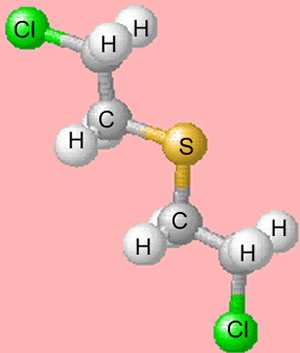Science of Conflict
Chemical warfare -mustard gas
Mustard gas or dichlorodiethyl sulfide, causes severe burns to the eyes, skin and lungs. Its full effects are sometimes felt days later and cause severe incapacitation.
Mustard gas was an important development in chemical warfare, believed to have first been used near Ypres 12th July 1917.

Its chemical
formula is Cl-CH2-CH2-S-CH2-CH2-Cl,
as pictured on the right.
Mustard gas proved to be a very nasty poison for it could penetrate all
protective material at the time. It could penetrate clothing and masks
and only recently, with the discovery of urethane, can protective material
resist mustard gas.
Mustard gas is insoluble in water and therefore proved difficult to remove.
If troops survived the inhalation of mustard gas, exposure would surely cause cancer later in life. For this reason mustard gas was a feared poison. If inhaled it causes blistering of the lining of the lungs causing great distress and in severe cases death. Exposure to high concentration of mustard gas causes damage to the cornea of the eye and eventual blindness.

1) What is a blistering agent?
2) As mustard gas reacts with water it splits into highly toxic chemicals.
One of these chemicals is known as hydrochloric acid. Describe the effects
of hydrochloric acid on skin.
3) Why are the lungs so susceptible to mustard gas?
4) Why was mustard gas such a feared poison?
5) Was it effective as a lethal weapon?
6) Describe the impact of a mustard gas attack on enemy troops. Discuss with reference to the demand placed on medical resources, psychological impact.
7) Why was mustard gas not widely used during WW2?